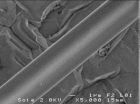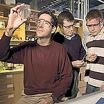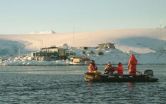(Press-News.org) WASHINGTON, Oct. 11—Spiders use their silk to catch lunch. Now physicists are using it to catch light. New research shows that natural silk could be an eco-friendly alternative to more traditional ways of manipulating light, such as through glass or plastic fiber optic cables. Two teams independently exploring possible applications for the material's photonic talents will present their latest breakthroughs at the Optical Society's (OSA) Annual Meeting, Frontiers in Optics (FiO) 2012, to be held next week in Rochester, N.Y.
Biomedical engineer Fiorenzo Omenetto of Tufts University in Boston will discuss his group's work fabricating concoctions of proteins that make use of silk's optical properties for implantable sensors and other biology-technology interfaces.
Physicist Nolwenn Huby at the CNRS Institut de Physiques de Rennes in France will talk about her team's use of pristine, natural spider silk to guide light through photonic chips—technology that could give birth to silk-based biosensors and medical imaging devices for use inside the body.
Both groups hope their work will lead to medical advancements that take advantage of the optical properties of silk. One of the strongest fibers in nature (the dragline used by spiders to form the structure of their webs is stronger, pound for pound, than steel), silk is biocompatible, biodegradable, and extremely hardy. Produced naturally by spiders and silkworms, it is a renewable resource. Added to these benefits is the more recent discovery that silk is a gifted manipulator of light, which can travel through silk almost as easily as it flows through glass fibers.
Though it may not be the best material in every one of these categories, the combination of talents is what makes silk such an attractive material to study, Omenetto explains. "There are materials that can do one of each, or a few of each," he says, "but seldom all of each."
Silk-based 'plastics' for implantable devices
In their efforts to exploit silk's optical merits, Omenetto's team is developing silk-based materials that look like plastic, but retain the optical properties of pristine silk. One of the advantages of these materials is that they can degrade and be reabsorbed by the body. A sensor or tag made of silk protein could be implanted—at the site of a fractured bone, for example, to monitor healing—and merely left to dissolve. Once its purpose had been served, the silk tag would harmlessly fade away.
Omenetto is currently investigating a range of questions, from fundamental to commercial, and they go beyond implantable optics. His team recently won an INSPIRE grant from the National Science Foundation to create electronic components that are compostable. He has developed and tested a blue laser made from silk fiber-doped materials that is not only biodegradable but also uses less power to induce lasing than the acrylic materials that are commonly used. He is also exploring the possibilities of using silk to integrate a technological component with living tissue. "We're thinking of how to scale up [production], how to interface with current technology," Omenetto says. He hopes some of the more "gadget-like" fruits of his labor will be commercially available within the next five to 10 years.
Guiding light with real silk
Silk-doped composites are the subject of Omenetto's talk at FiO, but the optical merits of pristine silk will be the subject of Huby's. Her team is experimenting with pure spider silk as a relatively inexpensive and ecologically friendly way to manipulate light within photonic chips.
As a light guide, silk works in a way comparable to the more commonly used glass microfibers that carry light within a chip; but silk comes out of the spider ready to use, whereas glass microfibers have to be heated to high levels and carefully sculpted at great expense. Huby's silk is collected by a group of molecular spectroscopy experts led by Michel Pézolet of Université Laval in Quebec, then integrated into circuits at her team's lab at Rennes. To her knowledge, this is the first time the optical properties of pristine silk have been exploited.
By integrating real spider silk into a microchip, the researchers found that silk could not only propagate light but could also direct light, or "couple" it, to selected parts of the chip. Huby hopes this work can be used to create biosensors that could detect the presence of a molecule or the activity of a protein: as light waves passed through a blood sample, for example, the molecules would change the properties of the light wave in an observable way.
The next step for Huby's team, she says, is to see what biologists and medical professionals need and then create devices they can use. Besides making biosensors, spider silk could also provide a light source for taking pictures inside of the body. Natural silk is only five microns in diameter, less than a tenth the width of a human hair. A pristine fiber of spider silk, which is so thin and strong, could carry light into the body through a very small opening, providing less invasive ways to do internal imaging or even chemical diagnoses using spectroscopy, which is the analysis of matter based on its interaction with light.
As a spokesman for silk's status as the material of the future—he gave a TED talk on the subject last year—Omenetto believes these recent successes will help more people become excited about the potential of this remarkable material.
"I like to think we threw a big stone in the pond," Omenetto says. "And hopefully the waves will continue."
INFORMATION:
Both presentations take place Monday, Oct. 15 at the Rochester Riverside Convention Center in Rochester, N.Y. Presentation FM3E.3. "Silk-based Optics and Photonics" by Fiorenzo Omenetto is at 2:30 p.m. followed by presentation FM3E.4 "Optical Propagation and Integration of Pristine Major Ampullate Spider Silk Fibers" by Huby et al. at 3 p.m.
EDITOR'S NOTE: High-resolution images are available to members of the media upon request. Contact Angela Stark, astark@osa.org.
PRESS REGISTRATION: A press room for credentialed press and analysts will be located in the Rochester Riverside Convention Center, Sunday through Thursday, Oct. 14-18. Those interested in obtaining a press badge for FiO should contact OSA's Angela Stark at 202.416.1443 or astark@osa.org. A full list of meeting highlights for press is available on the FiO website. http://www.frontiersinoptics.com/home/media-center/conference-news/optics-and-photonics-technology-leaders,-researche/
About the Meeting
Frontiers in Optics (FiO) 2012 is the Optical Society's (OSA) 96th Annual Meeting and is being held together with Laser Science XXVIII, the annual meeting of the American Physical Society (APS) Division of Laser Science (DLS). The two meetings unite the OSA and APS communities for five days of quality, cutting-edge presentations, fascinating invited speakers and a variety of special events spanning a broad range of topics in optics and photonics—the science of light—across the disciplines of physics, biology and chemistry. FiO 2012 will also offer a number of Short Courses designed to increase participants' knowledge of a specific subject in the optical sciences while offering the experience of insightful teachers. An exhibit floor featuring leading optics companies will further enhance the meeting. More information at http://www.FrontiersinOptics.org.
About OSA
Uniting more than 180,000 professionals from 175 countries, the Optical Society (OSA) brings together the global optics community through its programs and initiatives. Since 1916 OSA has worked to advance the common interests of the field, providing educational resources to the scientists, engineers and business leaders who work in the field by promoting the science of light and the advanced technologies made possible by optics and photonics. OSA publications, events, technical groups and programs foster optics knowledge and scientific collaboration among all those with an interest in optics and photonics. For more information, visit http://www.osa.org.
Eco-friendly optics: Spider silk's talents harnessed for use in biosensors, lasers, microchips
Researchers at Frontiers in Optics 2012 describe ways to use natural silk for implantable optics, compostable lasers, and microfibers integrated into photonic chips
2012-10-11
ELSE PRESS RELEASES FROM THIS DATE:
Airborne superbugs elude hospital cleaning regimes
2012-10-11
Hospital superbugs can float on air currents and contaminate surfaces far from infected patients' beds, according to University of Leeds researchers.
The results of the study, which was funded by the Engineering and Physical Sciences Research Council (EPSRC), may explain why, despite strict cleaning regimes and hygiene controls, some hospitals still struggle to prevent bacteria moving from patient to patient.
It is already recognised that hospital superbugs, such as MRSA and C-difficile, can be spread through contact. Patients, visitors or even hospital staff can inadvertently ...
India's public school students on par with private students
2012-10-11
EAST LANSING, Mich. — Contrary to past research, private school students in India do not outperform their counterparts in public schools, finds a new study by a Michigan State University education researcher.
The study challenges the claim that private schools are superior – a hot issue in India and other developing countries that are expanding K-12 educational offerings. During the past decade, some 40 million children have entered India's education system, giving rise to a growth in privately run schools.
"Our study finds no consistent benefit of attending a private ...
UMass Amherst research scores advance in manipulating T-cells
2012-10-11
AMHERST, Mass. – Until recently, medical researchers had little hope of experimentally manipulating naïve T cells to study their crucial roles in immune function, because they were largely impenetrable, says polymer scientist Gregory Tew: "So far off limits we could not readily get inside to investigate their workings."
Now, he and colleagues including immunologist Lisa Minter have found a way not only to get inside naïve T cells, but to deliver bio-active cargo such as proteins and synthetic molecules across that long-locked cell membrane, by using a new synthetic protein ...
New report examines potential impact of changes in Texas' Women's Health Program
2012-10-11
WASHINGTON and NEW YORK – A new report finds that Texas policies to exclude Planned Parenthood clinics from a state family planning program – the Women's Health Program (WHP) – would result in leaving tens of thousands of women unable to get care.
"Deteriorating Access to Women's Health Services in Texas: Potential Effects of the Women's Health Program Affiliate Rule," released by the Geiger Gibson/RCHN Community Health Foundation Research Collaborative in the Department of Health Policy of the George Washington University School of Public Health and Health Services, ...
Nerve signal discovery backs Nobel winner's theory
2012-10-11
Scientists have proved a 60-year-old theory about how nerve signals are sent around the body at varying speeds as electrical impulses.
Researchers tested how these signals are transmitted through nerve fibres, which enables us to move and recognise sensations such as touch and smell.
The findings from the University of Edinburgh have validated an idea first proposed by Nobel laureate Sir Andrew Huxley.
It has been known for many years that an insulating layer – known as myelin – which surrounds nerve fibres is crucial in determining how quickly these signals are ...
Arctic and Southern Oceans appear to determine the composition of microbial populations
2012-10-11
Differing contributions of freshwater from glaciers and streams to the Arctic and Southern oceans appear to be responsible for the fact that the majority of microbial communities that thrive near the surface at the Poles share few common members, according to an international team of researchers, some of whom were supported by the National Science Foundation (NSF).
In a paper published in the Oct. 8 edition of the Proceedings of the National Academy of Sciences (PNAS), the researchers report that only 25 percent of the taxonomic groups identified by genetic sequencing ...
England World Cup wins and losses linked to 30 percent rise in domestic violence
2012-10-11
Domestic violence rates rose by an average of 30 percent each time England won or lost their games during the 2010 World Cup, but draws had little impact on the statistics.
Those are the key findings of research carried out by statistician Professor Allan Brimicombe and BBC News journalist Rebecca Cafe and published in the October issue of Significance, the magazine of The Royal Statistical Society and the American Statistical Association.
As a consequence of this and previous research, Professor Brimicombe believes there is a strong case for schools to educate pupils ...
Plasma screens enhanced as disorder strikes
2012-10-11
A new study improves our understanding of plasma sources, a state of matter similar to gas in which a certain portion of the particles are ionised and which are used for example in plasma display panels. These results revealed by physicists from the University of Greifswald, Germany, Robert Wild and Lars Stollenwerk, and are about to be published in EPJ D.
Under certain circumstances, plasma tends to form structures such as filaments of electric discharge akin to mini-lightning. The authors specifically investigated a so-called barrier discharge, which features at least ...
Survey shows supplement users have strong interest in natural solutions to manage their cholesterol
2012-10-11
Montréal, Québec, Oct. 11, 2012 -- Over half (52 percent) of supplement users are concerned about their heart health and 73 percent express an interest in natural, clinically proven solutions for cholesterol reduction, according to market research conducted by Micropharma Limited, a pioneer in the development of innovative and effective probiotics.
"People are looking for naturally sourced supplements that work naturally with the body's systems for balance and control," said Mitchell Jones, MD, PhD, chief scientific officer and co-founder, Micropharma. "We are launching ...
Preemies from low-income families at high risk for dangerous brain bleeds
2012-10-11
Babies born prematurely to low-income parents have a disproportionately high risk for developing dangerous brain bleeds that require multiple surgeries and extensive follow-up, according to a small Johns Hopkins Children's Center study.
The findings - published online Sept. 28 in the journal Pediatric Neurosurgery and based on an analysis of 38 patients referred to Johns Hopkins for treatment of brain hemorrhages related to premature birth - offer a sobering reminder of the role socio-economic factors can play in health outcomes, the researchers say.
The link between ...
LAST 30 PRESS RELEASES:
Making lighter work of calculating fluid and heat flow
Normalizing blood sugar can halve heart attack risk
Lowering blood sugar cuts heart attack risk in people with prediabetes
Study links genetic variants to risk of blinding eye disease in premature infants
Non-opioid ‘pain sponge’ therapy halts cartilage degeneration and relieves chronic pain
AI can pick up cultural values by mimicking how kids learn
China’s ecological redlines offer fast track to 30 x 30 global conservation goal
Invisible indoor threats: emerging household contaminants and their growing risks to human health
Adding antibody treatment to chemo boosts outcomes for children with rare cancer
Germline pathogenic variants among women without a history of breast cancer
Tanning beds triple melanoma risk, potentially causing broad DNA damage
Unique bond identified as key to viral infection speed
Indoor tanning makes youthful skin much older on a genetic level
Mouse model sheds new light on the causes and potential solutions to human GI problems linked to muscular dystrophy
The Journal of Nuclear Medicine ahead-of-print tip sheet: December 12, 2025
Smarter tools for peering into the microscopic world
Applications open for funding to conduct research in the Kinsey Institute archives
Global measure underestimates the severity of food insecurity
Child survivors of critical illness are missing out on timely follow up care
Risk-based vs annual breast cancer screening / the WISDOM randomized clinical trial
University of Toronto launches Electric Vehicle Innovation Ontario to accelerate advanced EV technologies and build Canada’s innovation advantage
Early relapse predicts poor outcomes in aggressive blood cancer
American College of Lifestyle Medicine applauds two CMS models aligned with lifestyle medicine practice and reimbursement
Clinical trial finds cannabis use not a barrier to quitting nicotine vaping
Supplemental nutrition assistance program policies and food insecurity
Switching immune cells to “night mode” could limit damage after a heart attack, study suggests
URI-based Global RIghts Project report spotlights continued troubling trends in worldwide inhumane treatment
Neutrophils are less aggressive at night, explaining why nighttime heart attacks cause less damage than daytime events
Menopausal hormone therapy may not pose breast cancer risk for women with BRCA mutations
Mobile health tool may improve quality of life for adolescent and young adult breast cancer survivors
[Press-News.org] Eco-friendly optics: Spider silk's talents harnessed for use in biosensors, lasers, microchipsResearchers at Frontiers in Optics 2012 describe ways to use natural silk for implantable optics, compostable lasers, and microfibers integrated into photonic chips



